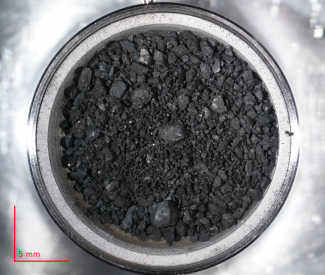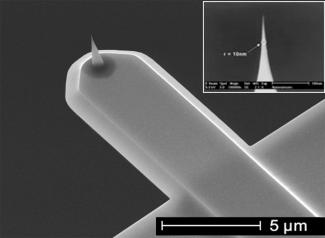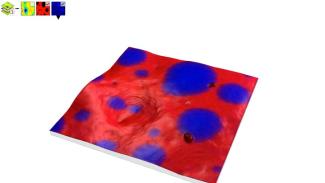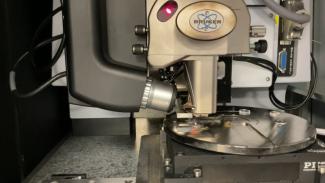
Live from asteroid Ryugu: analysis of extraterrestrial samples using atomic force microscopy and infrared spectroscopy
At the Institute of Physical Chemistry (ICP – Univ. Paris-Saclay, CNRS), the team in charge of infrared nanospectroscopy instruments is part of an international consortium aiming to analyse samples from the asteroid Ryugu, brought back to Earth by the Japanese space mission Hayabusa 2. Obtained in partnership with colleagues from the Laboratory of the Physics of the two Infinities Irène Joliot-Curie (IJCLab – Univ. Paris-Saclay, CNRS, Univ. Paris Cité), the Molecular Science institute of Orsay (ISMO – Univ. Paris-Saclay, CNRS) and the Muséum national d'histoire naturelle (MNHN), the initial results on the organic matter found in the Ryugu samples already promise further discoveries.
Through their organic compounds, asteroids and comets provide scientists with crucial information on the origin of the solar system, and even on early Earth. In the past, several space missions have been dedicated to exploring these small, solid celestial bodies. Chosen as the target of the Hayabusa 2 space mission, launched on 13 December 2014 by the Japan Aerospace Exploration Agency (JAXA), the asteroid Ryugu orbits in the rocky belt that stretches between Mars and Jupiter. With an average diameter of 900 metres, this asteroid is shaped like a spinning top or a diamond. It's a carbonaceous chondrite, whose low percentage of carbon atoms is enough to make it a dark object in the eyes of astrophysicists. The Hayabusa 2 probe reached the asteroid in June 2018, where it carried out studies in situ until November 2019. A capsule containing more than 5 grams of surface samples was then brought back on the return journey, landing in the Australian desert in December 2020. The samples were then sent to various laboratories for analysis.
The participation of the Institute of Physical Chemistry (ICP) in this analysis - and more specifically of the team in charge of the infrared nanospectroscopy instruments, led by Alexandre Dazzi, working alongside Ariane Deniset-Besseau and Jérémie Mathurin - owes much to its leader. In 2004, Alexandre Dazzi had the idea of combining an atomic force microscope (AFM) with a pulsed infrared laser. His aim was to perform infrared (IR) spectroscopy on a nanometric scale. IR spectroscopy detects molecular vibrations in order to identify chemical functions characteristic of the matter. Often used in conjunction with optical microscopy, it provides highly accurate, localised measurements, although its resolution is limited to a few micrometres (µm), a limit imposed by the phenomena of light diffraction. AFM probes the surface morphology of a sample using an extremely fine tip, with a precision of the order of about ten nanometres (nm). The combination of these two techniques provides chemical images with fine spatial resolution. For his discovery of AFMIR, the professor at Université Paris-Saclay was awarded the Grand Prix Raymond Castaing in 2023, which rewards researchers who have made outstanding contributions to microscopy in the broadest sense.
From Antarctic micrometeorites to the Ryugu asteroid
The ICP team's involvement in the Ryugu adventure came about thanks to a combination of circumstances. When Cécile Engrand, a researcher at IJCLab, and Jean Duprat, from MNHN, returned from Antarctica with ultra-carbonaceous Antarctic micrometeorites (UCAMMs), the scientists specialising in AFMIR mapped the organic matter contained in the skilfully prepared sample sections. They demonstrated the ability of AFMIR to measure associations between organic matter and minerals in inclusion sizes of only a few tens of nanometres - an achievement that Cécile Engrand and Jean Duprat then recounted to the members of Hayabusa 2. The ICP scientists were then contacted by the Japanese team, who were very interested in their method of analysis, and ended up receiving the famous samples from asteroid Ryugu.
But first - essential sample preparation
Before even thinking about analysing these samples, an essential first step was to develop the right protocol for preparing the sample surface. "If the material is too soft, it will be impossible to cut. If it's too hard, you won't be able to crush it," explains Jérémie Mathurin. Jérémie Mathurin and his two colleagues have carried out this work many times over the years, studying various materials and developing a certain expertise in the process. When the team got the intact grains (from 200 to 900 μm) as well as insoluble carbonaceous residues (isolated by acid treatment) from JAXA, it chose a diamond anvil cell to prepare the surface of the samples. The pressure simply crushed the material, leaving it open to a wide range of analyses.
A second step was then necessary. This involved identifying the main areas of interest. To do this, the team carried out infrared micro-spectroscopy analysis using the SOLEIL synchrotron, an electromagnetic instrument that accelerates elementary particles to very high energy levels. The radiation produced was then used to analyse chemical spectra at a range of wavelengths, albeit with lower resolution than AFMIR. "By targeting the areas highlighted by the synchrotron, we observed heterogeneities and new points of interest that would otherwise have remained invisible," adds Alexandre Dazzi.
Photothermal induced resonance technique
Equipped with a Bruker IconIR model, the team then began their search for organic matter, using the physical phenomenon at the heart of AFMIR: photothermal induced resonance. When the sample under analysis absorbed the pulses of the infrared laser, it expanded. The more radiation it absorbed, the more it expanded. This displacement was so small that even the nanometric tip was unable to detect it directly. However, it transmitted the induced vibration to the lever supporting it, like a tuning fork, which gave the scientists a measurement of the amount of infrared light absorbed by the material beneath the tip. This information was then linked to a chemical bond using wavelength. By proceeding in the same way for each wavelength of interest, it was possible to reconstruct the composition of the zone being studied.
Ryugu's composition tells of its history
Through their analysis, Alexandre Dazzi, Ariane Deniset-Besseau and Jérémie Mathurin have revealed the different types of organic matter present on asteroid Ryugu. The majority belong to aromatic carbons and their carbon-carbon bonds. Aliphatic carbons, typical of long linear carbon chains, were also visible. The team also uncovered the particular distribution of this organic matter in relation to the surrounding minerals. "Aromatic carbons were found inserted in silicate sheets, while aliphatic carbons appeared in concentrated systems," says Jérémie Mathurin. The compositions found on Ryugu are consistent with those expected for carbonaceous chondrites. These meteorites are known to have undergone aqueous alteration, i.e. reaction with liquid water. Ryugu, on the other hand, has little or no graphite-type material, which reduces the possibility that its parent body was subject to heating.
Viewed in combination, this information suggests that the asteroid's organic matter formed during (or even before) the early stages of the solar system's formation, in the interstellar medium or in the outer region of the protoplanetary disk (from which planets will emerge). The parent asteroid is thought to have then undergone a stage of aqueous alteration before suffering an impact ejecting material which, upon reassembling, gave birth to Ryugu.
After asteroids, why not Mars?
The members of the ICP are not yet finished with Ryugu and the extraterrestrial samples. At present, a PhD candidate in the team is continuing the analysis on new samples supplied by JAXA. In 2022, the team also applied to the Origins priority research programmes and equipment (PEPR) with its ASTRO-AFMIR (ASTROmaterials revealed by Atomic Force Microscopy-InfraRed) project and received funding of 1.6 million euros in September 2023. The main aim of this project is to acquire a new AFMIR specifically dedicated to mapping the chemical variations of organic and inorganic matter in extraterrestrial materials at the nanometric scale. Alexandre Dazzi makes no secret of the fact that the idea is "to be ready for future space missions with sample returns, especially those to Mars". This is why the new facility will be installed in a clean, neutral and controlled environmental chamber, to avoid any risk of contamination, whether Martian or Terrestrial. As part of ASTRO-AFMIR, the three ICP members are also committed to teaching between five and ten PhD candidates, post-doctoral fellows and research engineers.
Alexandre Dazzi, Ariane Deniset-Besseau and Jérémie Mathurin are also organising the first edition of a European convention focused on infrared nanospectroscopy: the European meeting on InfraRed Nanospectro-Imaging, which will be held from 12 to 15 March 2024 at Université Paris-Saclay. The programme includes workshops and conferences, and around one hundred attendees are expected at this event marking the 20th anniversary of the invention of the AFMIR technique.
Références :
- Hikaru Yabuta et al., Macromolecular organic matter in samples of the asteroid (162173) Ryugu. Science 379, eabn 9057 (2023).
- Jérémie Mathurin et al., Nanometre-scale infrared chemical imaging of organic matter in ultra-carbonaceous Antarctic micrometeorites (UCAMMs). A&A, Volume 622, February 2019.
- A. Dazzi, F. Glotin, R. Carminati. Theory of infrared nanospectroscopy by photothermal induced resonance. J. Appl. Phys. 15 June 2010; 107 (12): 124519.




